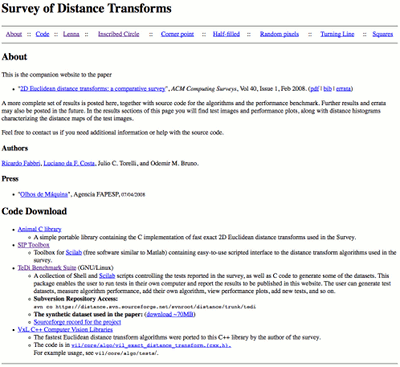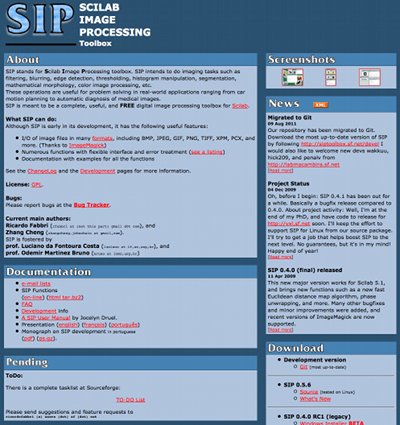SCG's Demos
The following links present demonstrations of methods, algorithms and systems devolped by SCG group research. Please, if some work is usefull for you, do not forget to cite.
CNDescriptors - A complex network-based approach for boundary shape analysis

This page provides the source code for the complex network-based approach for boundary shape analysis. In pattern recognition and image analysis, shape is one of the most important visual attributes to characterize objects. It provides the most relevant information about an object in order to identify and classify tasks.
The method proposed here, has a novel approach to the shape boundary analysis using the Complex Networks Theory. It considers the shape boundary as a set of points and models this set as a graph. The topology of a Small World network model is obtained artificially by transformations on vertices of shape model. The topological features, derived from the dynamics of the network growth, are correlated to physical aspects of the shape. Consequently, these measurements can be used to compose a shape descriptor or signature. These descriptors may be used to identify and distinguish objects.
Traditional shape boundary methods yield the shape descriptors using the contour as continuous closed curves formed by the adjacent consecutive pixels. By modeling the shape boundary as complex network, the method proposed here, on the other hand, does not need adjacent and sequential pixels as the graph model only takes the distance between the boundary elements into account. The page presents the demonstration and source-code of the paper:
Backes, A. R., Casanova D. and Bruno, O. M. "A complex network-based approach for boundary shape analysis". Pattern Recognition, 42(1):54-67, 2009.
Survey of Distance Transforms

This is the companion website to the paper "2D Euclidean distance transforms: a comparative survey", ACM Computing Surveys, Vol 40, Issue 1, Feb 2008. (pdf)(link).
A more complete set of results is posted there, together with source code for the algorithms and the performance benchmark. Further results and errata may also be posted in the future. In the results sections of this page you will find test images and performance plots, along with distance histograms characterizing the distance maps of the test images.
SIP - Scilab Image Processing Toolbox

SIP stands for Scilab Image Processing toolbox. SIP intends to do imaging tasks such as filtering, blurring, edge detection, thresholding, histogram manipulation, segmentation, mathematical morphology, color image processing, etc.
These operations are useful for problem solving in real-world applications ranging from car motion planning to automatic diagnosis of medical images.
SIP is meant to be a complete, useful, and FREE digital image processing toolbox for Scilab.
What SIP can do:
Although SIP is early in its development, it has the following useful features:
- I/O of image files in many formats, including BMP, JPEG, GIF, PNG, TIFF, XPM, PCX, and more. (Thanks to ImageMagick)
- Numerous functions with flexible interface and error treatment (see a listing)
- Documentation with examples for all the functions
License: GPL
Chaos based criptography

This is the companion website to the paper "Fast, parallel and secure cryptography algorithm using Lorenz's attractor", International Journal of Modern Physics C, 21(3):365-382, 2010 (pdf)(link).
A web version of the chaotic cryptography algorithm is fully funcional. The users can encrypt ASCII messages and files directly in the site. The site also claims the Hackers and crypto-anaylists to a challenge: Can you broke this crypto algorithm ?.
The site is wrotten in portuguese, but the crypto system can be easily used for people that does not understand portuguese.
General on-line demos
The following links present on-line demonstrations of general interest algorithms.
1D Wolfram's elementary celular automata on-lime demo

An interative Wolfram's elementary CA (implemented in Java) is presented. The user can change the automata rule and also choose the seeds options.
Butterfly effect on-lime demo

An interative Lorenz's attractor (implemented in Java) is presented. The user can observe the trajectory of two particles with very similar initial condictions. Very small differences in the initial condictions change the behavior of attractor during the time, which originate the famous analogies: "A butterfly flapping its wings in Brazil can set off a tornado in Texas". The user can interact with the 3D Lorenz's attractor
KNN on-lime demo

Knn stands for k-nearest neighbors, it's a pattern recognition algorithm that, as the name suggests, work with the k-nearest given samples to determine to which class an unowned sample belongs. The user can interact with an examples and try few parameters.
